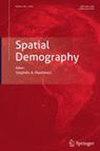The Advantages of Comparative LISA Techniques in Spatial Inequality Research: Evidence from Poverty Change in the United States
IF 1.1
Q3 DEMOGRAPHY
引用次数: 0
Abstract
Although scholarship regarding spatial inequality has grown in recent years, past research has seen limited use of spatial statistics—let alone comparison between spatial statistical techniques. Comparing and contrasting the application and use of spatial statistics is valuable in research because it allows for more precise identification of spatial patterns, and highlights results that may be hidden when only using a single method. This study serves as a demonstration on how the use of multiple LISA statistics can benefit inequality related research. Analyzing changes in county level poverty in the rural United States from 1990 to 2015 serves as a tool to demonstrate these techniques and this study examined how the geographic distribution of poverty has changed, and well as if there is evidence of diffusion effects. The three featured techniques utilized Local Indicators of Spatial Association (LISA) statistics. The techniques are Bivariate LISA, LISA Cluster Transitions, and LISA Diffusion Transitions, with the last technique specifically designed for this study. Each technique varies in how it reports the changes in the spatial structure of poverty. Bivariate LISA and LISA Cluster Transitions are complementary to each other—with the former technique providing a single global statistic while the latter is more easily interpretable. Diffusion Transitions show how the highest and lowest values of a variable may be spreading over time. The study also produces new findings regarding rural poverty, with poverty in Mountain-West and rural Sun Belt counties on the rise. Analysis shows a diffusion effect for poverty in Southeastern metropolitan fringe counties.比较 LISA 技术在空间不平等研究中的优势:美国贫困变化的证据
尽管近年来有关空间不平等的学术研究有所增长,但过去的研究对空间统计的使用却很有限,更不用说对空间统计技术进行比较了。比较和对比空间统计的应用和使用在研究中很有价值,因为这样可以更精确地识别空间模式,并突出仅使用单一方法时可能被掩盖的结果。本研究展示了多种 LISA 统计方法的使用如何有益于与不平等相关的研究。分析 1990 年至 2015 年美国农村地区县级贫困人口的变化是展示这些技术的工具,本研究考察了贫困人口的地理分布发生了怎样的变化,以及是否存在扩散效应的证据。三种特色技术利用了地方空间关联指标(LISA)统计。这三种技术分别是双变量 LISA、LISA 集群过渡和 LISA 扩散过渡,其中最后一种技术是专门为本研究设计的。每种技术报告贫困空间结构变化的方式各不相同。双变量 LISA 和 LISA 聚类过渡互为补充--前者提供单一的总体统计数据,而后者更易于解释。扩散过渡显示了变量的最高值和最低值是如何随着时间的推移而扩散的。研究还得出了有关农村贫困的新发现,即西部山区县和阳光带农村县的贫困率在上升。分析表明,东南部大都市边缘县的贫困现象具有扩散效应。
本文章由计算机程序翻译,如有差异,请以英文原文为准。
求助全文
约1分钟内获得全文
求助全文
来源期刊

Spatial Demography
DEMOGRAPHY-
自引率
0.00%
发文量
12
期刊介绍:
Spatial Demography focuses on understanding the spatial and spatiotemporal dimension of demographic processes. More specifically, the journal is interested in submissions that include the innovative use and adoption of spatial concepts, geospatial data, spatial technologies, and spatial analytic methods that further our understanding of demographic and policy-related related questions. The journal publishes both substantive and methodological papers from across the discipline of demography and its related fields (including economics, geography, sociology, anthropology, environmental science) and in applications ranging from local to global scale. In addition to research articles the journal will consider for publication review essays, book reviews, and reports/reviews on data, software, and instructional resources.
 求助内容:
求助内容: 应助结果提醒方式:
应助结果提醒方式:


